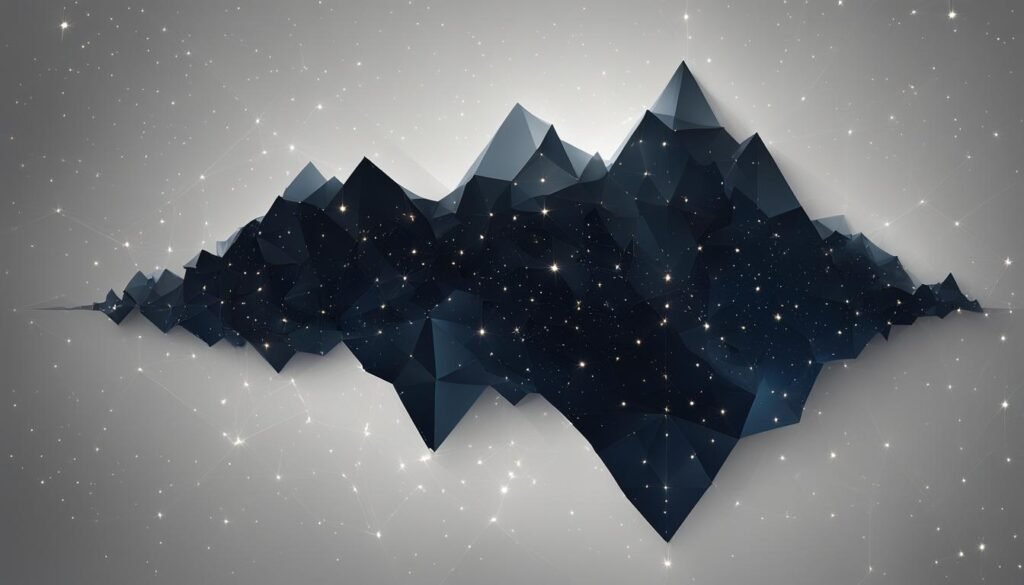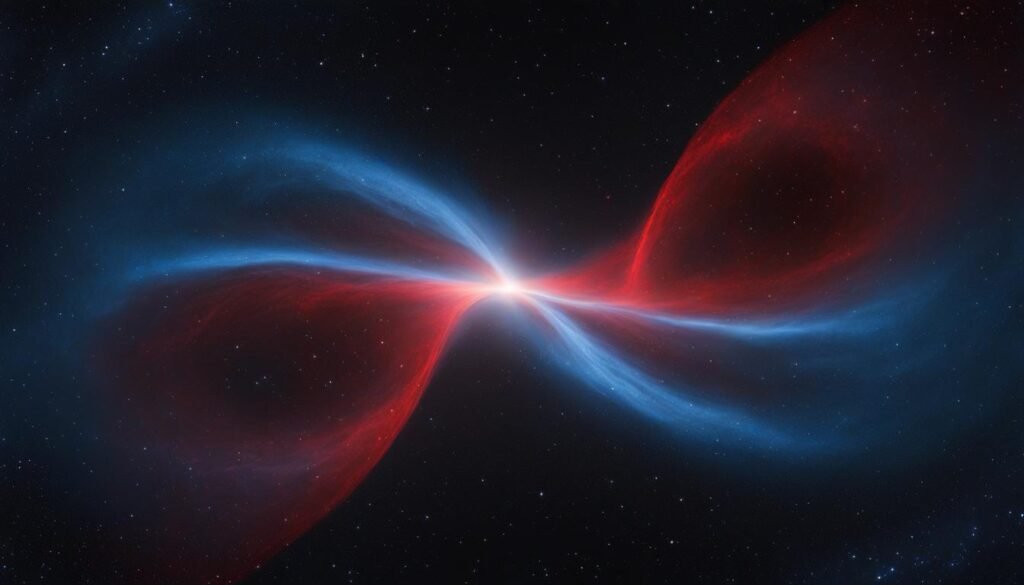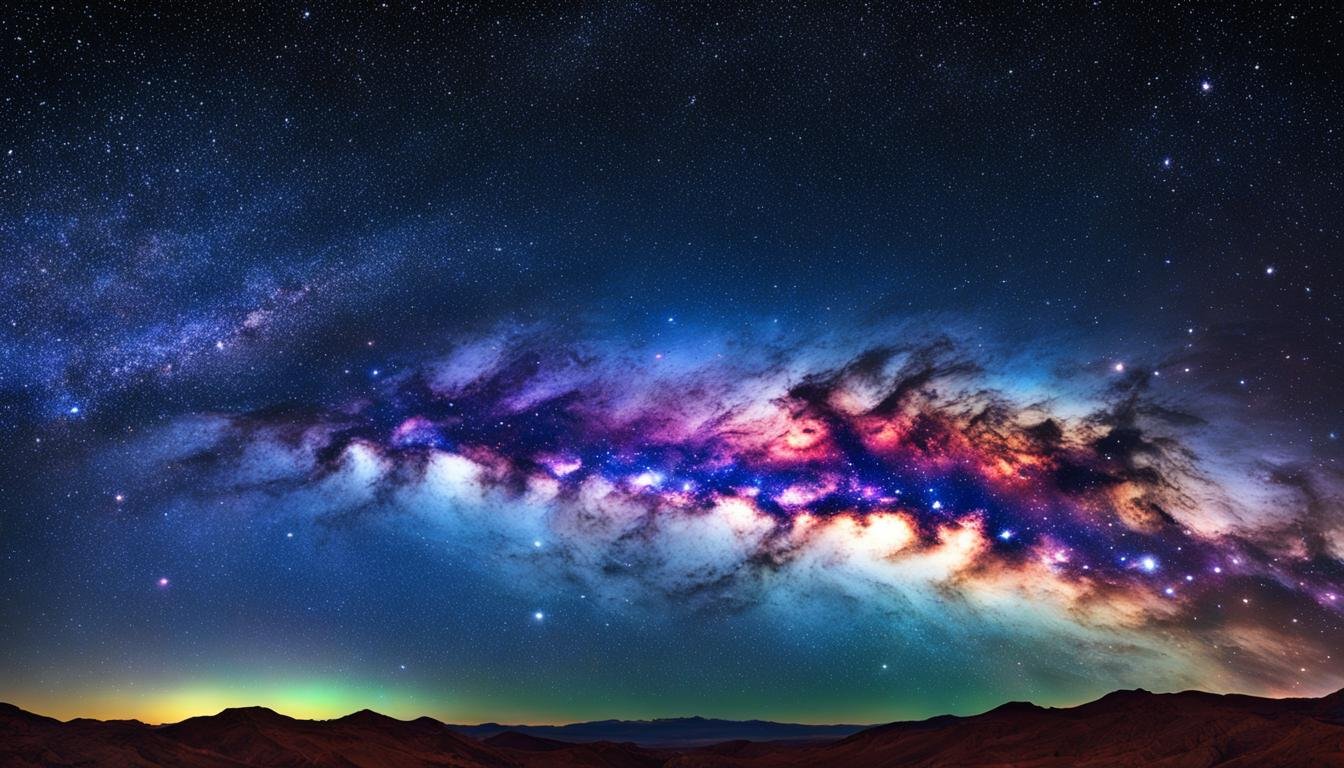| Genitive | |
| Abbreviation | |
| Pronunciation | |
| Main Stars | |
| Brightest Star | |
| Right Ascension | |
| Declination | |
| Sq. Deg. Area | |
| Crosses Meridian | |
| Visible Lat. Range |
Welcome to the stars, where the Constellation Musca twinkles in the vastness of the cosmos. As you explore Constellation Musca, immerse yourself in the history and the celestial choreography that renders it a true southern sky marvel. Often overlooked next to its more famous neighbors, Musca—the Latin term for ‘the fly’—awaits your discovery with a treasure trove of astronomical wonders hidden within its bounds.
Dive in and let this Musca constellation guide be your star map as you journey through the night sky. Engage with the wonders of Musca zodiac, from the binary stars fringed with mystery to nebulae sculpting the interstellar medium into awe-inspiring vistas.
Key Takeaways
- Uncover the history behind the Constellation Musca, discovered in the 16th century.
- Identify Musca’s place beneath the Southern Cross in the celestial sphere.
- Learn about Musca’s brightest star, Alpha Muscae, and its unique characteristics.
- Acknowledge Musca’s role in celestial navigation for southern seafarers.
- Prepare to observe Musca’s deep-sky objects with tips for amateur astronomers and stargazers.
- Appreciate the innovation and legacy of Dutch navigators in documenting this southern sky marvel.
- Gain insight into how to spot this constellation and its neighboring astronomical wonders.
Unveiling the Constellation Musca: An Overview
Embark on a celestial journey as we explore the intricate tapestry of the nighttime sky, featuring the intriguing Constellation Musca. Boasting a rich tapestry intertwined with Constellation Musca history, this section will illuminate the stars’ remarkable past, their steadfast presence in celestial navigation, and how they’ve been charted in the cosmic sea throughout the ages.
History and Discovery: Tracing Back to Dutch Navigators
Delve into the annals of the night sky where the Constellation Musca’s narrative begins with pioneering Dutch navigators and Musca. Unraveling like a celestial atlas, the narrative extends from Dutch explorers Pieter Dirkszoon Keyser and Frederick de Houtman, who used the stars as guides on their expeditions. These navigators, through their voyages to the East Indies, became instrumental in bringing the Musca constellation into recognition. Later immortalized by Cartographer Petrus Plancius and making its mark on the stellar charts by Johann Bayer as ‘Apis,’ Musca has transformed in name and stature over the eons, settling on the backdrop of the southern celestial hemisphere.
Position in the Night Sky: Size and Visibility
Within the celestial hemisphere, Musca spans a modest 138 square degrees, earning its rank as the 77th constellation in terms of size. Its residence in the SQ3 quadrant positions it to the south of the celestial equator, with optimal visibility in latitudes ranging from +10° and -90°. Telescopes pointed toward the heavens reveal that Musca casually meanders near other cosmic marvels including the Southern Cross neighbor, Carina, and Centaurus. Musca gleams especially bright with the brilliance of Alpha Muscae, a luminary that offers navigators a reliable point of right ascension.
Navigation by the Stars: Musca’s Role for Seafarers
As the sky evolves over the hours of the night, the role of Musca endures. The southern circumpolar constellation has captivated the gaze of mariners for centuries, being an immutable guide near the south celestial pole. Its circumpolar nature implies its permanence above the horizon, an eternal watchman for those navigating by stars. Moreover, the proximity of Musca to well-known navigational waypoints like the Southern Cross solidifies its significance in the realm of Musca celestial navigation, providing a celestial compass to those undertaking seafaring voyages beneath the southern skies.
Astronomical Significance of Musca Star Sign
Deep in the night sky, the Musca constellation quietly narrates an astronomical tale that may have been overlooked by those only scanning the skies for the most luminous spectacles. However, for those who pause and reflect, Musca star sign importance becomes increasingly apparent. As you explore the astrology of Musca, there exists a rich tapestry woven from Musca celestial bodies, presenting a chance to deepen your cosmic curiosity.
You may find that the Musca constellation, free from the crowds of ancient Greek and Roman mythological tales, carries its own enigmatic presence. The stories and Musca constellation myths that do exist echo the journeys and discoveries of sailors long past, charting over oceans guided by the stars. Musca’s subtle glow is indicative of its role in the grander celestial narrative, playing its part in the transitional journey of stars—a pivotal chapter in our ongoing efforts to unravel the mysteries of the cosmos.
Among the celestial ensemble, the star Alpha Muscae stands out not only for its brightness but as a compelling example of a celestial body transitioning from one stage of its stellar life cycle to another. This process offers insight into the evolutionary pathways that govern the lives of stars, which, in turn, influences our understanding of the universe’s intricate workings.
| Celestial Entity | Type | Observational Significance |
|---|---|---|
| Alpha Muscae | Single Star | Brightest in Musca, exhibits transitional evolutionary state |
| Nova Muscae 1991 | Binary System | Contains black hole candidate, vital for studying mass transfer phenomena |
| Spiral Planetary Nebula (NGC 5189) | Planetary Nebula | Showcases complex gas expulsion processes during late-star life phases |
Though it does not dominate the celestial stage with pomp and splendor, Musca’s understated brilliance offers a humble reminder of the varying scales and stories within the array of the night sky. As you contemplate Musca’s star sign importance, embrace the opportunity to broaden your perspective and appreciate the subtle narrative that this distinctive constellation contributes to the impressive expanse of the universe.
Constellation Musca: Star Composition and Notable Features
Delving into the Musca constellation’s intricate tapestry, you’ll find a fascinating assortment of astral feats and cosmic landmarks. From the illustrious Alpha Muscae, the constellation’s most luminous beacon, to the enigmatic Nova Muscae 1991, Musca is a treasure-trove of celestial phenomena that continues to captivate astronomers and stargazers alike. These stellar constituents not only enhance our knowledge of the universe but also offer exceptional viewing experiences under the night sky.
Alpha Muscae: The Beacon of Musca
The blue-white star known as Alpha Muscae stands as Musca brightest star, a testament to the exquisite beauty of this southern constellation. With its dual classification as a Beta Cephei variable and subgiant star, Alpha Muscae balances on the brink of stellar evolution and displays an extraordinary light display indicative of its variable status. Its surface pulsations give rise to subtle fluctuations in brightness, making it a remarkable subject for observation and study.
Nova Muscae 1991: A Black Hole Binary System
In the realm of Musca, Nova Muscae 1991 presents a celestial riddle, contributing to the constellation’s repute as a harbor for black hole systems. This binary system is particularly invaluable to the scientific community for its inclusion of a suspected black hole. Encircling this gravitational giant, an accretion disk funnels material from a nearby star, offering astoundingly vivid X-ray novae displays and affording a peek into the dynamic processes that shape our cosmos.
Enhance Your Viewing Experience: Tips for Spotters
For those eager to embark on observing Constellation Musca, a few strategic Musca stargazing tips can significantly amplify your experience. To accomplish optimal constellation spotting, it is advised to seek out locales shrouded in darkness, away from the glare of city lights. Such conditions are optimal in the Southern Hemisphere, where Musca is readily seen. Remember, locating the Southern Cross can serve as a guidepost, leading your gaze to the fascinating features that dwell within Musca’s boundaries.

| Feature | Viewing Tips | Best Time to Observe |
|---|---|---|
| Alpha Muscae | Look for a bright, blue-white star. A simple pair of binoculars can aid in observing its fluctuations. | April and May during the early evening hours |
| Nova Muscae 1991 | Seek areas with minimal light pollution; a telescope is recommended to observe X-ray activity. | Late December, though X-ray activity can vary |
By adhering to these Musca viewing recommendations, you’ll enrich your night-sky exploration and uncover the wonders cast across the celestial canvas by the Musca constellation wonders.
Exploring Deep Sky Objects in Musca’s Territory
As you journey across the cosmos, the constellation Musca serves as a treasure trove for anyone passionate about deep sky exploration. From the stunning Hourglass Nebula to the enigmatic Dark Doodad Nebula, Musca’s celestial domain offers outstanding marvels. Let’s embark on a voyage to uncover these southern celestial objects, examining their distinct characteristics and contributions to the tapestry of the night sky.
The Luminous Hourglass Nebula: A Celestial Masterpiece
Among the most identified planetary nebulae is the Engraved Hourglass Nebula, a true spectacle in the vast interstellar medium. Through the eyes of the Hubble Space Telescope, this nebula showcases intricate patterns resembling a delicate hourglass sculpted by the forces of the cosmos. A testament to the dynamic end stages of a star’s life, the Hourglass Nebula lures astronomers and the curious alike, becoming a symbol of the ethereal beauty inherent in stellar evolution.

The Hidden Gems: Globular Clusters within Musca
Further enriching Musca’s array of wonders are the impressive globular clusters NGC 4372 and NGC 4833. These dense congregations of stars offer a glimpse into the early universe, locked in a spherical embrace. As you observe these globular clusters in Musca, you’re peering into ancient gatherings that provide vital clues to our galaxy’s history and the dynamic interactions within.
| Globular Cluster | Magnitude | Notable Features |
|---|---|---|
| NGC 4372 | 7.8 | One of the largest and oldest known in the sky |
| NGC 4833 | 7.8 | Notable for its dense core and surrounding star halo |
The Intriguing Dark Doodad Nebula: A Space Mystery
Lastly, the phantom presence of the Dark Doodad Nebula stretches across Musca, a dark brushstroke against the galaxy’s luminous canvas. It’s a linear form of dust and cold gas blocking out the light from stars behind it, creating an absorbing effect that fuels the intrigue of nebular observation. This hidden gem is an alluring sight for anyone drawn to the unsolved mysteries of star formation within Musca.
Your celestial journey through Musca uncovers diverse expressions of cosmic phenomena, from radiant planetary nebulae to clustered remnants of a primordial past. These southern celestial objects, nestled within this constellation’s bounds, continue to captivate stargazers and astronomers, sparking a yearning for further deep sky exploration.
Musca Celestial Bodies: Legends and Myths
As you delve into the stories twinkling across the night sky, you’ll find that while the Musca constellation legends might not be woven into the fabric of ancient mythology, they possess a maritime legacy all their own. Predominantly known among navigators and those who traverse the southern seas, Musca symbolizes the uncharted territories that were mapped following human curiosity and the spirit of exploration. This lesser-known star ensemble, best observed in May, carries the tales of its discovery by the Dutch astronomer Petrus Plancius and stands as a testament to the era of celestial cartography that expanded our view of the heavens.
The lack of myths of Musca astrology can be considered unique, marking it as one of the few constellations whose stories are not of the gods but of mankind’s ambition. It is in this context that Musca has earned its stripes, narrating a history rich with naval lore and stargazing wonders. The constellation’s visibility in the southern hemisphere’s skies made it a crucial navigational aid for those reliant on the stars. To the eyes of a sailor, every point of light in Musca was not just a beacon in the ocean’s vast darkness but also a symbol of guidance and hope.
The star patterns within Musca are engaging not because of the Musca celestial tales they inspired, but rather for the distinct absence of such mythology. In this void, an opportunity is presented to us to craft new stories, drawing inspiration from the constellation’s actual application by those explorers who first charted our worlds beyond. As you gaze upon Musca, consider the constellation as a celestial canvas, inviting us to project our own narratives onto its stellar backdrop, celebrating the unwritten stories held within its realm.
FAQ
What is the historical significance of the Constellation Musca?
The Constellation Musca holds historical significance due to its discovery by Dutch navigators in the late 16th century. It first appeared in a celestial atlas in Johann Bayer’s Uranometria in 1603. Its history is tied to maritime navigation in the southern hemisphere, with its presence as a reliable guide for those at sea.
Where can I find the Constellation Musca in the night sky?
You can find the Constellation Musca in the southern sky, located just below the Southern Cross (Crux). It’s best viewed between the latitudes of +10° and -90°. It’s part of the SQ3 quadrant of the celestial hemisphere and is easily spotted due to its proximity to the south celestial pole and well-known neighboring constellations.
What celestial bodies are part of the Musca constellation?
Musca constellation is home to various celestial bodies including Alpha Muscae, its brightest star, and several deep-sky objects like the binary system Nova Muscae 1991, the Spiral Planetary Nebula (NGC 5189), and the Hourglass Nebula (MyCn 18). In addition, you’ll find globular clusters such as NGC 4372 and NGC 4833, and the Dark Doodad Nebula within its bounds.
Does Musca have any astrological significance?
Unlike other constellations with well-known astrological influences, Musca does not have a link to modern astrology practices. Its significance lies more within the realm of astronomy and navigation rather than astrology.
How can I enhance my view of the Constellation Musca?
To enhance your view of the Constellation Musca, you should aim for dark and clear skies, which are often found in the Southern Hemisphere. Utilizing binoculars or a small telescope can help in observing Musca’s fainter stars and its deep-sky features. Look for the Southern Cross as a reference point, and Musca should be visible just beneath it.
Are there any myths associated with the Constellation Musca?
The Constellation Musca does not have myths associated with it in the same way as other constellations named after ancient Greek or Roman myths. Its origins are firmly rooted in more modern astronomy, introduced by navigators and explorers in the 16th century rather than ancient storytelling.
What is the best time to observe the Constellation Musca?
The best time to observe the Constellation Musca is during the month of May when it is ideally positioned in the night sky for viewers in the Southern Hemisphere.
Why were navigators particularly interested in the Constellation Musca?
Navigators were interested in the Constellation Musca because of its position near the south celestial pole and its status as a southern circumpolar constellation, meaning it could be used as a constant navigational reference point throughout the year from southern latitudes.
Does Musca belong to any constellation family?
Yes, Musca is a member of the Johann Bayer family of constellations. These constellations were featured in Bayer’s atlas Uranometria and are mostly positioned in the southern celestial hemisphere.






